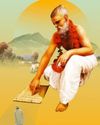
Siddhi, another student from the same school has created a model that cuts water usage by 90%. Impressed, the school headmaster implemented her model in the school.
The school is currently teaching over 600 students. Despite its label of being a government school, it is training its students in the skills of the future: flying drones, creating 2-D and 3-D animation, coding, photography, robotics, sound engineering, farming, along with sports, music, and languages. Based on their interest, the students pursue one of these skills or modules, as they are called. And students are not just excelling in their chosen skills. They are also acing state board exams. In the recent 2019 exams, 47 students from the school secured state merit scholarship.
“Compared to the West, our country lacks inventions. I want to contribute to my country with new inventions,” says Vedant. Till now, he has made a vacuum machine, an LED bulb, a voting machine, and a smart dustbin which opens whenever an object comes near it. He, along with his classmates, is now working on making a model of a wificar. Recently, he was part of the school team that won the fourth prize in the worldwide First Tech Challenge Robotics Competition.
A brainchild of the school headmaster, Dattatray Ware, the school’s curriculum is equipping children to solve everyday problems and problems of the future. “We don’t provide these kids with readymade solutions. So, they solve problems on their own. They have made models on their own, using digital platforms like Youtube,” says Dattatray, who further adds that the sole inspiration behind such a dynamic curriculum is children.
This story is from the September 2020 edition of Rishimukh.
Start your 7-day Magzter GOLD free trial to access thousands of curated premium stories, and 8,500+ magazines and newspapers.
Already a subscriber ? Sign In
This story is from the September 2020 edition of Rishimukh.
Start your 7-day Magzter GOLD free trial to access thousands of curated premium stories, and 8,500+ magazines and newspapers.
Already a subscriber? Sign In
Feel Grateful And Be Happy
Teens & Kids
Q & A ith Gurudev
When we fail, who is the doer?

Bhågåwåt Gïtå
The Song of the Divine

THE PURSUIT OFHAPPINESS
A classic example of how you can thrive during times of pain and adversity and emerge a winner in your own right

SINDHU DARSHAN A TRIBUTE TO INDIA
The festival of Sindhu Darshan is an evocative and endearing celebration to honour the River Sindhu and promote ethnic diversity of India

Epitome of Knowledge SIDDHAR BOGAR
One of the 18 siddha purushas of the siddha lineage in South India, Bogar was a great mystic with unique miraculous powers and had incredible knowledge in a variety of fields and disciplines. We bring you a glimpse of this great yogi’s extraordinary feats.
YOGA The Life Jacket of Strength & Solace
Meditation happens, you can’t do it. You can only create a congenial atmosphere for it to happen.

Nearer than the Nearest
DIDI WRITES

The Real Source of Knowledge
What must a seeker embrace to gain Absolute Knowledge? Read on...

“I FOUGHT COVID AND WON A LOSING BATTLE!”
READERS SPACE